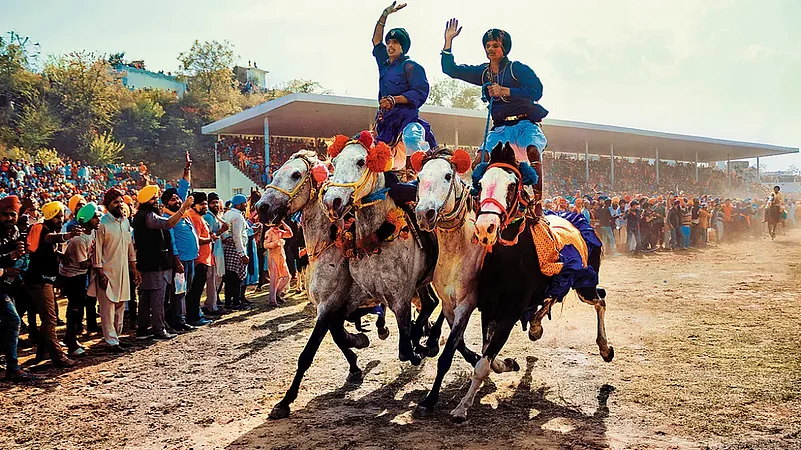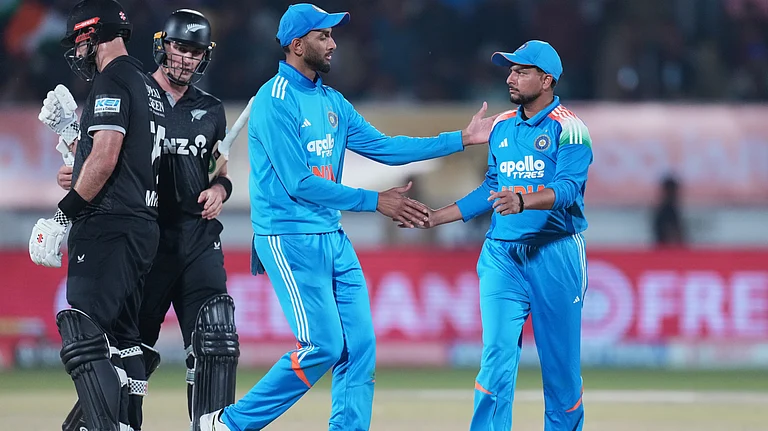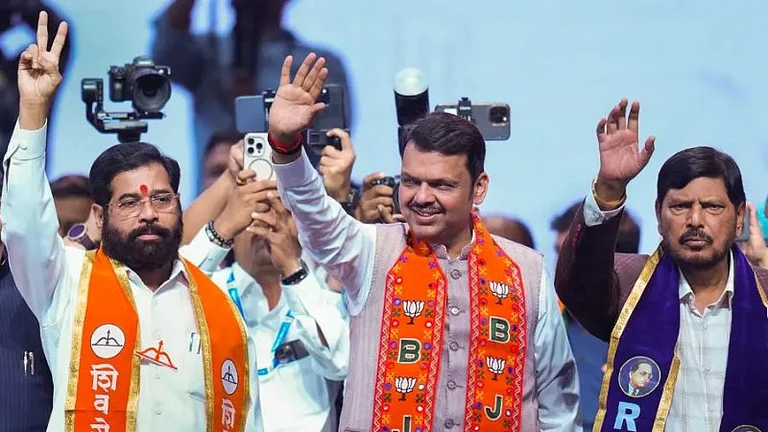Standing on the boundary of his small field, Harpal Singh stares at the moon as it drifts in the farm stream. There is an air of melancholy about him. When asked about the reason for his pensive demeanour, he says, a bit reluctantly, “This crop that is now ready for harvesting was sown by my father. I was at the Delhi border at that time. After finishing the sowing Bapu joined me there and gave up on life in the bitter cold that followed.” His eyes begin to well up. I look at the farm. A sheet of golden sunshine has spread over it. Late March is the time when the Rabi crop is nearly ripe and the wheat stalks nod happily in a winnowing wind that begins to blow.
Although not much has changed on the ground, there have been forces at work that have torn asunder the soul of its people, the fabric of its society and the vibe in its ambience. The people of Punjab are, however, the hardiest of the lot as historically they have always taken the divisive forces, the invaders, whether from within or without, head on. And they have lived through all this with a broad smile and with a spirit that is by now aptly known as ‘Panjabiyat’. Yes, the indomitable happy spirit that allows them to live the day to the hilt, going by the age old saying “Khada peeta lahe da/te rehnda Ahmad shahe da” (What you eat and drink today is yours, the rest will be pillaged by Ahmad Shah Abdali, who invaded Punjab thrice between 1747-53.)
It is this spirit that has always defined the Punjabi character, making them the people that they are: bold, experimental, not cowing down to authority easily, rebellious and yet deeply sensitive. Some of the things that have been reiterated through the results of the recent elections wherein they have been courageous enough to put their much-loved state in the hands of a party totally new to the soil. All this because they have waited long enough to break the shackles of fiefdom that have brought down the once-prosperous state to the threshold of near poverty. But Punjabis have fought on.
“Hun nahi (not anymore, not now),” says Nirmal Kaur of Mansa who has lost three young sons to the drug menace. She rues the day when her eldest one first took the injection and the malaise took the younger two in its fold quickly. She looks longingly at three pictures perched on a ramshackle sandook, their marigold garlands all dried up. “When I was young this was not the case,” Nirmal goes on. “Hun taan araam naal milan lag gayi si (The damn thing was not so easy to acquire).” Now all you need is money to buy and they squandered away everything before dying of an overdose. “My Punjab back then was not Udta Punjab,” she goes on to say, referring to the Bollywood movie of the same name and based on the drug menace. “My husband and I worked hard in the fields but there was peace and happiness at the end of the day.” She looks wistfully at an old man lying on a broken cot, disinterested in life.
ALSO READ: Paradox And Dilemma Of UP's Hindi Literati
But Nirmal goes on nostalgically. “The Punjab of my girlhood days was a contented state, enthusiastically celebrating its festivals. I remember the melas and how excited we girls used to be, the sound of the merry-go-rounds, the creak of the carousel horses filled us with joy and we would be coaxing bapuji to let us go. A permission that was always granted with a few conditions but we were fine with that. It was in one of these melas that I met Gurkirat’s bapu (her husband).” A shy smile plays on her lips and she talks with downcast eyes.
Though melas are still held but they are much more commercialised now. It seems the time of those sly glances and pink blushes rising is over now. Girls and boys easily connect with each other through cellphones. Even children who earlier played gulli danda, jung planga in the village maidan seem to have given up these games except, of course, for those who cannot afford a cellphone. The rains fall still and streets get flooded but the origami boats are there no longer. Basant Panchami is still a gazetted holiday but colourful kites are hardly seen in the indigo skies of Punjab. In my time dor used to be prepared with manjha, much ahead of Basant and one could see rows and rows of these colourful threads drying along the streets.
Punjabis, however, still swear by their pride and virility. I was pleasantly amused by the celebrations that took place in certain friend circles when Vicky Kaushal, a Punjabi, married the gorgeous Katrina Kaif, making her “Punjab di noonh”. It took me back to the time when our very own Dharam paaji married the dream girl, Hema Malini, the most desirable woman of her times. Songs from their films could be heard at every nook and corner of Punjab villages. Here I would like to mention my visits to the cinema halls as a young woman. The moment a Sikh appeared on the screen everyone would laugh derisively, a mischievous glint shone in the eyes of people as they waited for the Sikh to crack his next silly joke. He was always the butt of ridicule, a blabbering taxi driver and a sidekick. Almost a large-hearted joker of the pack. Being from a Sikh family, it was hard to hide my embarrassment as my friends doubled in their seats with laughter. By now, however, cinema has come a long way from the days of Mehar Mittal clumsily trying to hold on to his ever-falling pants.

It was not fashionable to be a Sikh. Even girls of Sikh families back then preferred to marry a “cut surd” a term that came into being back then. It showed their preference for the Punjabi culture in which they were brought up but not for marrying someone who would perhaps not mingle easily in the crowd. Not so anymore, and I must say that even Bollywood discovered the potential of a Sikh character. Top heroes vie with each other to don the pagri, be it Ajay Devgn, Akshay Kumar, Saif Ali Khan or our very own Sunny paaji or even Farhan Akhtar, who played the legendary Milkha Singh, and the entire world danced to the foot-tapping number Slow Motion Angreza. Punjabis are here to rule the celluloid world, and in the real world beautiful brides now swoon over their turbaned grooms.
ALSO READ: And Unquiet Flows The Yamuna
The music industry too has been enriched by Punjabi folk songs and their foot-tapping rhythm. If earlier, it was just a Shamshad Begum song saying Harha ni harha haner pai gya (Oh damn look! It’s the doomsday), today no Bollywood flick is complete without a Punjabi-based song. Be it Lal Ghagra or Paani da rang. Dialogues are also often written with a Punjabi flavour and everyone admires and enjoys them to the core. Chandigarh Kare Ashiqui could be the latest case in point. Even OTT is banking heavily upon Punjabi. Some thirty years ago, one could not have imagined any of this. We, as Punjabis, are equally indebted to the entertainment industry. Had it not been for the remixes of songs like Chan kithan guzari raat, it would have been quite a task for us to introduce our children and grandchildren to this rich heritage and cultural tropes.
As always, the literature of the land is the one that reflects/preserves the mindsets as well as the changes in the life and society of its people. Prof Mohan Singh celebrated the spirit of a time as well as mourned a shift in perspective when he wrote Chhatto di Beri. O kidhar gaye dihade/jad chhatto de pichhvade/saan ber chhatto de dhande/has has k gallan khande (O where have those days gone/when we brought down jujube/from a fruit tree in Chhato’s backyard/and laughed at the expletives she hurled) This was perhaps a lament for urbanisation and for the narrow-mindedness that crept in at times.
ALSO READ: The Decline Of Urdu In UP's Literary World
Dr Surjit Patar, the celebrated contemporary Punjabi poet, wrote about the trend of brain drain that took place a few decades ago. Hence, it is said metaphorically that half of Punjab lives in Canada. Jo bideshan ch ruled ne roti layi/ghar aapne jadon partan k kadi/kujh taan sekange maa de sive di agan/baki kabran de rukhan heth jaa behenge (Those who chase mirages in alien lands/shall come back home one day/and a few may warm their hands by the mother’s pyre/and others shall go and sit under the graveyard trees.)
Also, a distinct shift in the women’s voice can also be heard. Amrita Pritam, the first Punjabi woman poet to make her mark on the world map a few decades ago, was a revolutionary in her own right. Nevertheless, she has lamented the stance of the male vis-a-vis his relationship with a woman. Asin jagg vali bazi jit jaande/je tun dukki vi rang di laa denda (We would have won this worldly game/if you had played even the smallest card right). But the shift can be seen a few years later when poet Vanita says: Sidharth! iss vaar nirvana di prapti layi tun nahi Yashodhra jaavegi (Sidharth ! this time not you but Yashodhra shall go in search of nirvana) And Paul Kaur declares complete independence from all shackles. “Khulle ne sire hun (All ends are open now).”
ALSO READ: Interpreter Of Hindustani Maladies
Such is the spirit of contemporary Punjab. It is fierce, it is independent and there to take its place in the world. Be it the Punjab of a few decades ago or the Punjab that has recently shown what an actual democratic people can do, Surjit Patar has amply summed up the Punjabi spirit. Main raahan te nahi turda/main turda haan taan raah bande (I do not walk on existing paths/my footprints make the paths).
(This appeared in the print edition as "Life, Kingsize")
(Views expressed are personal)
ALSO READ
Arvinder Kaur is an author, translator and poet





















